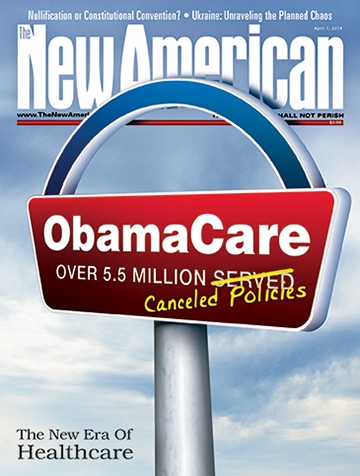Inside Track
President Proposes Doubling Tax Subsidy for the Poor
President Obama’s proposal to double the earned income tax credit (EITC) for the working poor on March 4 came with all the promises of attendant benefits that such an expansion would provide: It would reduce poverty while encouraging people who are not working to get jobs, and it would expand existing law to cover an additional 16 million families, with 30 million children.
In his State of the Union address in January, the president warned this was coming, while noting that good conservatives like Marco Rubio (R-Fla.) endorsed such an increase:
Right now, [the EITC only] helps about half of all parents … but I agree with Republicans like Senator Rubio that it doesn’t do enough for single workers who don’t have kids.
So let’s work together to strengthen the credit, reward work, and help more Americans get ahead.
At present, under the EITC, workers get back 7.65 cents on every dollar they earn up to $6,570, for a maximum bonus of $503. That bonus from the federal government stays constant until he earns $8,220, after which the bonus starts to decrease. It disappears altogether once his earnings hit $14,790 a year. Proponents theorize that this bonus adds additional incentive for low-paid workers to continue to work to gain higher incomes, but at a certain point they’re earning enough to be weaned off the government subsidy.
Under Obama’s enhanced offering, workers would get back 15.2 cents for each dollar they earn up to $6,570, for a maximum bonus of $1,005. That would stay constant until their income hits $11,500 and then decrease to zero at $18,070 a year.
The present program favors working poor with children, while those without children who earn low wages receive little. Without children, a worker earning minimum wage would receive just $161 under the present program. Through Obama’s generosity, he would receive $823. A 23-year-old making $15,000 a year wouldn’t get a government check under today’s EITC law. Under Obama’s, she would get a check for $470.
The president pointed to various studies that “proved” that the present program had lifted some families above the poverty level while encouraging some stay-at-home moms to enter the workforce. But he saved his big guns for the skeptics who saw this as just another expansion of the welfare state. In his announcement, the president wrote:
At least since President Reagan signed into law the Tax Reform Act of 1986 there has been widespread agreement on the principle that Federal taxes should not push people into or deeper into poverty [but instead] should expand opportunity.
And then, he added the pièce de résistance: Such expansion of benefits would be free: "The … proposal to expand the childless worker’s EITC would advance all of these goals, without adding to deficits."
That was on page 14. On page 15 came the bad news: There would, by necessity, be tax increases to pay for the program, including raising taxes on those rich hedge fund managers who have been taking part of their compensation in the form of capital gains, which are taxed at a rate that “is significantly below the income and payroll taxes that a manager would owe on comparable salary income [which is] less than the effective Federal income and payroll tax rate for a single childless worker making $50,000 [a year].”
On page 16, the “free” expansion would also be funded by closing a loophole that high-income entrepreneurs have been using for years through Subchapter S corporations which “takes $5 billion per year [away] from Social Security and Medicare Trust Funds.”
These changes are all positive, according to the president: "These proposals will help reorient the tax code to reward work for low-wage workers while making sure that highly-compensated professionals pay taxes on their incomes like everyone else."
Though Obama didn't get into them, there are other claimed advantages to the EITC, originally proposed by alleged conservative economist Milton Friedman in his 1962 book, Capitalism and Freedom. Said Friedman, a “negative income tax” would allow the government to simplify things, getting rid of the whole alphabet-soup anti-poverty agencies — now totaling more than 300 and transferring more than $400 billion annually — such as food stamps (now SNAP), rent subsidies, unemployment insurance, and other efforts. Wrote Friedman at the time:
We should replace the ragbag of welfare programs with a single, comprehensive program of income supplements in cash — a negative income tax. It would provide an assured minimum to all persons in need, regardless of the reasons for their need.
In 1975, a narrower version of Friedman’s “negative income tax” — the EITC — was signed into law under President Gerald Ford, and has been enlarged and expanded under every president since, whether Democrat or Republican.
In 2010, a pro-EITC group produced a bill to turn the program into a full-on guaranteed annual income for every American, but the bill never got traction. Undeterred, that group, called the U.S. Basic Income Guarantee Network, continues to promote its agenda. Allan Sheahen, a board member, wrote Guaranteed Income: The Right to Economic Security in 1983, which to date hasn’t been reviewed by any readers at Amazon.com. Ever determined, he wrote another one, Basic Income Guarantee, which has been garnering some attention from just the sort of individuals one would expect. Before passing from the scene in October 2012, the Democratic Party presidential candidate of 1972 George McGovern touted Sheahen’s effort:
This book is a great idea — brilliantly stated. Some may think it’s ultra-liberal, as they did when I proposed a similar idea in 1972.
I see it as true conservatism — the right of income for all Americans sufficient for food, shelter, and basic necessities. Or, what Jefferson referred to as life, liberty, and the pursuit of happiness.
It also received praise from Bob Filner, a far-left progressive from California who resigned under a cloud last August:
Allan Sheahen places the idea of a basic income for all Americans squarely back on the national agenda. In plain English, this radical idea is not only clearly explained but answers even the toughest objections that can be raised.
This book should make sense even to my most dysfunctional colleagues in Congress.
Those dysfunctional colleagues Filner referred to probably take heart from having a complete understanding of the fallacies inherent in any government transfer program. Most were laid out succinctly by Henry Hazlitt in his 1969 book Man vs. The Welfare State.
First, a negative income tax distorts the English language. It is a tax subsidy taken from someone who earned it and transferred to someone who didn’t. Said Hazlitt:
Trick names of this sort corrupt the language and confuse thought. It would hardly clarify matters to call a [government] handout a “negative deprivation” or having your pocket picked “receiving a negative gift.”
Aside from the moral problems of invading the right to private property, a "negative tax" is bound to grow immensely. Hazlitt (who was writing just as the EITC scheme was gathering momentum under President Nixon) reasoned:
I have already pointed out that proponents have put out calculations as high as $38 billion a year, but we may be confident that their cost figures are systematically underestimated, even for the early years.
And if once the main principle … were accepted, the minimum subsidy or guarantee demanded would be bound constantly to increase.
For the record, in 2013, the cost of the EITC scheme approached $60 billion, and that was before the doubling of the program proposed by the president in January.
In addition, Hazlitt predicted that implementation of such a program would not replace any existing welfare state programs but would instead be piled on top of them:
So knowing what we do of political pressures, and of the past history of relief, "social insurance," and other "antipoverty" measures, we are forced to conclude that once the principle of either the NIT or the straight guaranteed income were accepted, it would be made an addition to and not a substitute for the present conglomeration of relief and "antipoverty" programs.
And even alone it would drastically reduce the productive incentives of those earning less than the guaranteed amount and seriously reduce the incentives of those earning more, because of the oppressive taxation it would necessarily involve.
Its overall effect would be to level real incomes down, not up.
Indirectly, in his critique of the proposed EITC program back in 1969, Hazlitt touched on another point too often ignored in the debate: the growing incentive by the receivers to outvote the providers. After implementation of a government giveaway, attempts to remove the franchise from welfare recipients soon become foolish:
Yet as long as the great and growing army now on various forms of relief and welfare programs retains the right to vote for those who promise them still more of other people's money, we may expect to see relief and welfare programs grow to the point where they eventually undermine the currency and bring on national bankruptcy.
Such attempts to level the playing field and restore equality through government force direct attention away from the only real and lasting way to increase everyone’s standard of living: removing restrictions on the private capitalist system, which is the only system in human history to have reduced poverty. If such programs based upon dividing up a fixed pie of goods and services worked so well, why don’t they get exported to countries filled with the wretched poor? Says Hazlitt:
Why don't the advocates of a guaranteed income insist that this right be enforced first of all in the poor countries, such as India and China, where the need is most widespread and glaring?
The reason is simply that even the better-off groups in these nations have not produced enough wealth and income to be expropriated and distributed to others.
The greatest danger of such transfer programs, however, is what it does to a free society. By assuming that the pie is fixed in size, and that poverty can only be alleviated by taking from the rich and giving to the poor, incentives to produce are reduced on both parties:
Shortsighted and impatient efforts to wipe out poverty by severing the connection between effort and reward can only lead to the growth of a totalitarian state, and destroy the economic progress that this country has so dearly bought.
As Hazlitt tried to look into the distant future, he was remarkably prescient and insightful. Passing in 1993, his predictions have proved unnervingly accurate:
The burden of taxation will steadily be increased to pay for the rising benefits. The attempt will be made to place the increased burden mainly on corporations and high individual incomes. This will further erode incentives and discourage the production upon which the welfare of all of us depends.
Government expenditures will continue to increase faster than the new tax revenues, bringing a return to chronic deficits, monetary inflation, and a further fall in the purchasing power of people's insurance policies, pensions, and savings deposits.
The president’s plan to double the EITC program to be paid for by higher taxes on the rich was uncannily predicted by Hazlitt more than 45 years ago. He is gone, but his truths remain. Despite surface attractiveness and support for such programs by alleged conservatives, sending money to people who haven’t earned it violates the primary underlying principle of a free society: the right to private property. To say that what one earns isn’t his unless the government says so turns sovereign citizens into slaves.



